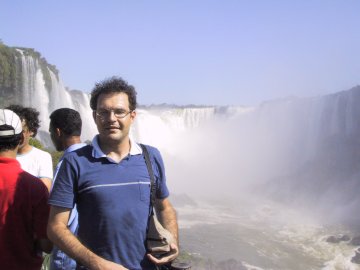Foz do Iguaçu – water, lots of it
November 20, 2006 4:21 pm gnome, wengoI was in Brazil last week, thanks to the funding of the GNOME Foundation, at Latinoware, giving a presentation “Getting started in free software” – a personal description of how I got involved in free software, and the lessons I have learned through it. I spoke about my experiences in the free software world, including my time with the GIMP,GNOME and OpenWengo. Before going, I didn’t really know what to expect. This was my first visit to South America, and while I had heard lots of good things about the free software community there, nothing prepared me for what we saw.

Joao Bueno of the GIMP at the falls
Foz do Iguaçu is a small town in Western Brazil dominated by two impressive landmarks – the Iguaçu falls, a dazzling array of waterfalls that stretched for several kilometers on the Argentina-Brazil border, and the hydro-electric power station at Itaipu, the biggest operational hydro-electric power station in the world. Latinoware was held in the grounds of Itaipu, about 2 kilometers from the dam.
On Wednesday, I got to visit the falls – an amazing experience. The array of wildlife on show is unbelievable, with Toucans, lizards, spiders, and the Wilber-like coati, the mascot of the town. And then there is the falls. According to Wikipedia, they consist of about 270 waterfalls, along a 2.7 km stretch of the Iguaçu river which divides Brazil from Argentina.
Itaipu is also amazing. The power station generates 25% of all of the electricity needs of Brazil, and 95% of the needs of Paraguay. One turbine of the Itaipu plant is 10 meters in diameter, and generates 700 MW of energy – more than enough to fulfill the needs of a city the size of Lyon.
I also got to visit Ciudad del Este, a free trade zone in Paraguay, across the Parana river from Foz. It reminded me of those no-man’s-land cities you occasionally see in spy films. This one city represents 60% of Paraguay’s GDP. You could buy anything – electronics, arms and clothes are apparently the most popular items.

The amazing Latinoware crowd
Thursday morning, I gave my keynote presentation in Itaipu. As I said, I didn’t know what to expect – the last thing I was expecting was 1200 free software advocates, mostly between 18 and 25 years old, coming to the conference. Aside from the size and age of the crowd, one other thing surprised me – the amount of women. A rough estimate put the number of female participants between 10 and 20 percent – coming from Europe, where we’re used to counting on the fingers of a few hands the number of women at a free software conference, seeing hundreds of women at the conference was a refreshing change. One last surprise was waiting for me in the opening addresses – several politicians, including Marcus Mazzoni, a former guest at GUADEC, and member of the regional government in the state of Parana, spoke of free software not just as a way of cutting costs, but first and foremost about sharing and community. First and foremost, free software is a social and cultural phenomenon in Brazil. I doubt many French politicians understand so well what free software is all about.

Women in Free Software
My presentation went well, I think – perhaps because the point above is one I hold close to heart. Free software is all about communities forming around ideas, and those communities are human. Almost everyone who gets involved in free software development gets involved through a friend. I also talk about the motivating factors people have which make free software attractive to them – and the thing that ties us together, I think, is the feeling that we’re part of something bigger than ourselves, that we’re taking part in a movement, which is slowly changing the way the world sees technology, and the way technology gets created. We are changing the world.